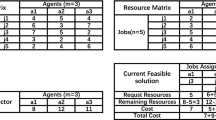Abstract
We propose a performance enhancement using parallelization of genetic operations that takes highly fit schemata (building-block) linkages into account. Previously, we used the problem of solving Sudoku puzzles to demonstrate the possibility of shortening processing times through the use of many-core processors for genetic computations. To increase accuracy, we proposed a genetic operation that takes building-block linkages into account. Here, in an evaluation using very difficult problems, we show that the proposed genetic operations are suited to fine-grained parallelization; processing performance increased by approximately 30 % (four times) with fine-grained parallel processing of the proposed mutation and crossover methods on Intel Core i5 (NVIDIA GTX5800) compared with non-parallel processing on a CPU. Increasing GPU resources will diminish the conflicts with thread usage in coarse-grained parallelization of individuals and will enable faster processing.











Similar content being viewed by others
References
Mantere T, Koljonen J (2006) Solving and rating Sudoku puzzles with genetic algorithms. In: Proceedings of the 12th Finnish artificial conference STeP 2006, pp 86–92, Espoo, 26–27 Oct 2006
Nicolau M, Ryan C (2006) Genetic operators and sequencing in the GAuGE system. In: IEEE congress on evolutionary computation 2006 (CEC 2006), pp 1561–1568, Vancouver, 16–21 July 2006
Mantere T, Koljnen J (2008) Solving and analyzing Sudokus with cultural algorithms. In: IEEE Congress on Evolutionary Computation 2008 (CEC 2008), pp 4053–4060, Hong Kong, 1–6 June 2008
Sato Y, Inoue H (2010) Solving Sudoku with genetic operations that preserve building blocks. In: IEEE symposium on computational intelligence and games (CIG) 2010, pp 23–29, Copenhagen, 18–21 Aug 2010
Wikipedia, Backtracking. http://en.wikipedia.org/wiki/Backtracking. Cited 1 Nov 2011
Byun JH, Datta K, Ravindran A, Mukherjee A, Joshi B (2009) Performance analysis of coarse-grained parallel genetic algorithms on the multi-core sun UltraSPARC T1. In: IEEE Southeastcon, SOUTHEASTCON’09, pp 301–306, 5–8 March 2009
Serrano R, Tapia J, Montiel O, Sep’ulveda R, Melin P (2008) High performance parallel programming of a GA using multi-core technology. In: Soft computing for hybrid intelligent systems. Studies in computational intelligence, vol 154, Springer, Berlin, pp 307–314
Tsutsui S, Fujimoto N (2009) Solving quadratic assignment problems by genetic algorithms with GPU computation: a case study. In: Proceedings of the 11th annual conference companion on genetic and evolutionary computation conference: late breaking papers (GECCO’09), pp 2523–2530, Montreal, 8–12 July 2009
Munawar A, Wahib M, Munetomo M, Akama K (2009) Theoretical and empirical analysis of a GPU based parallel bayesian optimization algorithm. In: Proceedings of the international conference on parallel and distributed computing, applications and technologies (PDCAT’09), IEEE, pp 457–462, Hiroshima, 8–11 Dec 2009
Sato Y, Hasegawa N, Sato M (2011) Acceleration of genetic algorithms for Sudoku solution on many-core processors. In: Proceedings of the 2011 ACM/SIGEVO GECCO workshop on computational intelligence on consumer games and graphics hardware CIGPU-2011, pp 407–414, Dublin, 12–16 July 2011
Wikipedia, Sudoku. http://en.wikipedia.org/wiki/Sudoku. Cited 8 March 2010
Lewis R (2007) Metaheuristics can solve Sudoku puzzles. J Heuristics 13(4):387–401
Simonis H (2005) Sudoku as a constrain problem. In: Proceedings of 4th international workshop modeling and reformulating constraint satisfaction problem, pp 13–27
Lynce I, Ouaknine J (2006) Sudoku as a SAT problem. In: 9th international symposium on artificial intelligence and mathematics (AIMATH’06), Fort Lauderdale, 4–6 Jan 2006
Moon TK, Gunther JH (2006) Multiple constrain satisfaction by belief propagation: an example using Sudoku. In: 2006 IEEE mountain workshop on adaptive and learning systems, pp 122–126, 24–26 July 2006
Goldberg DE (1989) Genetic algorithms in search optimization and machine learning, 1st edn. Addison-Wesley Longman Publishing Co., Inc., Boston
Goldberg DE, Sastry K (2001) A practical schema theorem for genetic algorithm design and tuning. In: Proceedings of the 2001 genetic and evolutionary computation conference, Morgan Kaufmann, USA, pp 328–335
Harik GR, Goldberg DE (1996) Learning linkage. In: Foundations of genetic algorithms 4, pp 247–262
LaTorre A, Peña JM, Robles V, De Miguel P (2008) Supercomputer scheduling with combined evolutionary techniques. In: Metaheuristics for scheduling in distributed computing environments, studies in computational intelligence, vol 146, Springer, Berlin, pp 95–120
Number Place Plaza (eds) (2008) Number place best selection 110, vol 15, ISBN-13: 978-4774752112, Cosmic mook
Super difficult Sudoku’s. http://lipas.uwasa.fi/~timan/sudoku/EA_ht_2008.pdf#search=‘CT20A6300%20Alternative%20Project%20work%202008’. Cited 8 March 2010
Acknowledgments
This research is partly supported by the collaborative research program 2012, Information Initiative Center, Hokkaido University, and a grant from the Institute for Sustainability Research and Education of Hosei University 2012.
Author information
Authors and Affiliations
Corresponding author
About this article
Cite this article
Sato, Y., Inoue, H. & Sato, M. Parallelization of genetic operations that takes building-block linkage into account. Artif Life Robotics 17, 17–23 (2012). https://doi.org/10.1007/s10015-012-0012-x
Received:
Accepted:
Published:
Issue Date:
DOI: https://doi.org/10.1007/s10015-012-0012-x




